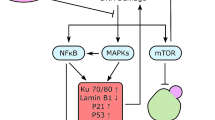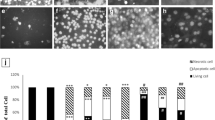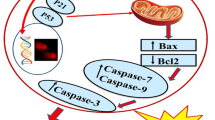Abstract
There is a lot of interest in the health benefits of dietary carotenoids and on the relationship of these compounds with smoke. In particular, it is unknown if the enhanced cancer risk observed in smokers following β-carotene supplementation can be also found using other carotenoids. Here, we studied the effects of the tomato carotenoid lycopene on molecular pathways involved in cell cycle progression, apoptosis and survival in immortalized RAT-1 fibroblasts exposed to cigarette smoke condensate (TAR). Lycopene (0.5–2.0 μM) inhibited cell growth in a dose-and time-dependent manner, by arresting cell cycle progression and by promoting apoptosis in cells exposed to TAR. The arrest of cell cycle was independent of p53 and of 8-OH-dG DNA damage and related to a decreased expression of cyclin D1. Moreover, the carotenoid up-regulated apoptosis and down-regulated the phosphorylation of AKT and Bad in cells exposed to TAR. Such an effect was associated to an inhibition of TAR-induced expression of Cox-2 and hsp90, which is known to maintain AKT activity. This study suggests that lycopene, differently from β-carotene, can exert protective effects against cigarette smoke condensate.
Similar content being viewed by others
References
Mayne ST. Beta-carotene, carotenoids, and disease prevention in humans. FASEB J 1996; 10: 690–701.
Alpha-tocopherol, Beta-carotene Cancer Prevention Study Group. The effect of vitamin E and β-carotene on the incidence of lung cancer and other cancers in male smokers. N Engl J Med 1994; 330: 1029–1035.
Omenn GS, Goodman GE, Thornquist MD, et al. Risk factors for lung cancer and for intervention effects in CARET, the Beta-Carotene and Retinol Efficacy Trial. J Natl Cancer Inst 1996; 88: 1550–1559.
Omenn GS, Goodman GE, Thornsquist MD, et al. Effects of a combination of beta-carotene and vitamin A on lung cancer and cardiovascular disease. N Engl J Med 1996; 334: 1150–1155.
Hennekens CH, Buring JE, Manson JE, et al. Lack of effect of long-term supplementation with β-carotene on the incidence of malignant neoplasm and cardiovascular disease. N Engl J Med 1996; 334: 1145–1149.
Wang XD, Liu C, Bronson RT, Smith DE, Krinsky NI, Russell RM. Retinoid signaling and Activator Protein-1 expression in ferrets given β-carotene supplements and exposed to tobacco smoke. J Natl Cancer Inst 1999; 91: 60–66.
Liu C, Wang XD, Bronson RT, Smith DE, Krinsky NI, Russell RM. Effects of physiological versus pharmacological beta-carotene supplementation on cell proliferation and histopatological changes in the lungs of cigarette smoke-exposed ferrets. Carcinogenesis 2000; 21: 2245–2253.
Obermueller-Jevic UC, Espiritu I, Corbacho AM, Cross CE, Witschi H. Lung tumor development in mice exposed to tobacco smoke and fed β-carotene diets. Toxicol Sci 2002; 69(1): 23–29.
Perocco P, Paolini M, Mazzullo M, Biagi GL, Cantelli-Forti G. β-carotene as enhancer of cell transforming activity of powerful carcinogens and cigarette-smoke condensate on BALB/c3T3 cells in vitro. Mutat Res 1999; 440: 83–90.
Palozza P, Serini S, Di Nicuolo F, et al. β-carotene exacerbates DNA oxidative damage and modifies p53-related pathways of cell proliferation and apoptosis in cultured cells exposed to tabacco smoke condensate. Carcinogenesis 2004; 25: 1–11.
Khachik F, Splanger CJ, Smith JC Jr, Canfield LM, Pfander H, Steck A. Identification, quantification and relative concentrations of carotenoids and their metabolites in human milk and serum. Anal Chem 1997; 69: 1873–1881.
Steinmetz KA, Potter JD. Vegetables, fruits and cancer. I Epidemiology. Cancer Causes Control 1991; 2: 325–337.
Block G, Patterson B, Subar A. Fruit, vegetables and cancer prevention. A review of the epidemiological evidence. Nutr Cancer 1992; 18: 1–29.
Cohen JH, Kristal AR, Stanford JL. Fruit and vegetable intakes and prostate cancer risk. J Natl Cancer Inst 2000; 92: 61–68.
Giovannucci E, Ascherio A, Rimm EB, Stampfer MJ, Coldtz GA, Willett VC. Intake of carotenoids and retinol in relation to risk of prostate cancer. J Natl Cancer Inst 1995; 87: 1767–1776.
Cohen LA. A review of animal model studies of tomato carotenoids, lycopene, and cancer chemoprevention. Exp Biol Med 2002; 227: 864–868.
Prakash P, Russell RM, Krinsky NI. In vitro inhibition of proliferation of estrogen-dependent and estrogen-independent human breast cancer cells treated with carotenoids or retinoids. J Nutr 2001; 131: 1574–1580.
Ben-Dor A, Nahum A, Danilenko M, et al. Effects of acyclo-retinoic acid and lycopene on activation of the retinoic acid receptor and proliferation of mammary cancer cells. Arch Biochem Biophys 2001; 391: 295–302.
Levy J, Bosin E, Feldman B, et al. Lycopene is a more potent inhibitor of human cancer cell proliferation than α-carotene or β-carotene. Nutr Cancer 1995; 24: 257–266.
Amir H, Karas M, Giat J, et al. Lycopene and 1,25-dihydroxyvitamin D3 cooperate in the inhibition of cell cycle progression and induction of differentiation in HL-60 leukemic cells. Nutr Cancer 1999; 33: 105–112.
Karas M, Amir H, Fishman D, et al. Lycopene interferes with cell cycle progression and insuline-growth factor I signalling in mammary cancer cells. Nutr Cancer 2000; 36: 101–111.
Nahum A, Hirsch K, Danilenko M, et al. Lycopene inhibition of cell cycle progression in breast and endometrial cancer cells is associated with reduction in cyclin D levels and retention of p27(Kip1) in the cyclin E-cdk2 complexes. Oncogene 2001; 20: 3428–3436.
Pastori M, Pfander H, Boscoboinik D, Azzi A. Lycopene in association with alpha-tocopherol inhibits at physiological concentrations proliferation of prostate carcinoma cells. Biophys Res Commun 1998; 250: 582–585.
Liu C, Lian F, Smith DE, Russell RM, Wang XD. Lycopene supplementation inhibits lung squamous metaplasia and induces apoptosis via up-regulating insulin-like growth factor-binding protein 3 in cigarette smoke-exposed ferrets. Cancer Res 2003; 63: 3138–3144.
Xu A, Wu LJ, Santella RM, Hei TK. Role of oxyradicals in mutagenicity and DNA damage induced by crocidolite asbestos in mammalian cells. Cancer Res 1999; 59: 5922–5926.
Stedman RL. The chemical composition of tobacco and tobacco smoke. Chem Rev 1968; 68: 153–207.
Church DF, Pryor AW. Free-radical chemistry of cigarette smoke and its toxicological implications. Environ Health Perspect 1985; 64: 111–126.
Pryor WA. Cigarette smoke and the role of free radical species in chemical carcinogenicity. Environ Health Perspect 1997; 105: 875–882.
Pryor WA, Stone K, Zang LY, Bermudez E. Fractionation of aqueous cigarette TAR extracts: Fractions that contain the TAR radical cause DNA damage. Chem Res Toxicol 1998; 11: 441–448.
Truscott TG, Land EJ, Sykes A. The in vitro photochemistry of biological molecules. 3. Absorption spectra, lifetimes and rates of oxygen quenching of the triplet states of beta-carotene, retinal and related polyenes. Photochem Photobiol 1973; 17: 43–51.
Conn PF, Schalch W, Truscott TG. The singlet oxygen and carotenoid interaction. Photochem Photobiol 1991; 11B: 41–47.
Di Mascio P, Kaiser S, Sies H. Lycopene as the most efficient biological carotenoid singlet oxygen quencher. Arch Biochem Biophys 1989; 274: 532–538.
Bertram JS, Pung A, Churley M, et al. Diverse carotenoids protect against chemically induced neoplastic transformation. Carcinogenesis 1991; 12: 671–678.
Palozza P, Serini S, Torsello A, et al. Mechanism of activation of caspase cascade during beta-carotene-induced apoptosis in human tumor cells. Nutr Cancer 2003; 47: 76–87.
Yarborough A, Zhang YJ, Hsu TM, Santella RM. Immunoperoxidase detection of 8-hydroxydeoxyguanosine in aflatoxins B1-treated rat liver and human oral mucosal cells. Cancer Res 1996; 56: 683–688.
Kasai H, Crain PF, Kuchino Y, Nishimura S, Ootsuyama A, Tanooka H. Formation of 8-hydroxyguanine moiety in cellular DNA by agents producing oxygen radicals and evidence for its repair. Carcinogenesis 1986; 7: 1849–1851.
Faulks RM, Hart DJ, Scott KJ, Southon S. Changes in plasma carotenoid and vitamin E profile during supplementation with oil palm fruit carotenoids. J Lab Clin Med 1998; 132: 507–511.
Lane PD. p53, guardian of the genome. Nature 1992; 358: 15–16.
McDonald ER III, El-Deiry WS. Cell cycle control as a basis for cancer drug development (Review). Int J Oncol 2000; 16: 871–886.
Pommier Y, Sordet O, Antony S, Hayward R, Kohn KW. Apoptosis defects and chemotherapy resistance: Molecular interaction maps and networks. Oncogene 2004; 23: 2934–2949.
Sato S, Fujita N, Tsuruo T. Modulation of Akt kinase activity by binding to Hsp. Proc Natl Acad Sci 2000; 97: 10832–10837.
Shishodia S, Aggarwal BB. Cyclooxygenase (Cox)-2 inhibitor celecoxib abrogates activation of cigarette smoke-induced nuclear factor (NF)-kB by suppressing activation of IkBα kinase in human non-small cell lung carcinoma: Correlation with suppression of cyclin D1, Cox-2 and matrix metalloproteinase-9. Cancer Res 2004; 64: 5004–5012.
Palozza P, Serini S, Maggiano N, et al. β-carotene down-regulates steady-state- and heregulin-α-induced Cox-2 pathway through suppression of ERK1/2 activity in colon cancer cells: Changes in ROS production and apoptosis. J Nutr 2005; 135: 129–136.
Wertz K, Siler U, Goralczyk R. Lycopene: Modes of action to promote prostate health. Arch Biochem Biophys 2004; 430: 127–134.
Porrini M, Riso P. Lymphocyte lycopene concentration and DNA protection from oxidative damage is increased in women after a short period of tomato consumption. J Nutr 2000; 130: 189–192.
Bowen P, Chen L, Stacewicz-Sapuntzakis M, et al. Tomato sauce supplementation and prostate cancer: Lycopene accumulation and modulation of biomarkers of carcinogenesis. Exp Biol Med 2002; 227: 886–893.
Hall AK. Liarazole amplifies retinoid-induced apoptosis in human prostate cancer cells. Anticancer Drugs 1996; 7: 312–320.
Kotake-Nara E, Kushiro M, Zhang H, Sugawara T, Miyashita K, Nagao A. Carotenoids affect proliferation of human prostate cancer cells. J Nutr 2001; 131: 3303–3306.
Hwang ES, Bowen PE. Cell cycle arrest and induction of apoptosis by lycopene in LNCaP human prostate cancer cells. J Med Food 2004; 7: 284–289.
Hantz HL, Young LF, Martin KR. Physiologically attainable concentrations of lycopene induce mitochondrial apoptosis in LNCaP human prostate cancer cells. Exp Biol Med 2005; 230: 171–179.
Nara E, Hayashi H, Kotake M, Miyashita K, Nagao A. Acyclic carotenoids and their oxidation mixture inhibit the growth of HL-60 human promyelocytic leukaemia cells. Nutr Cancer 2001; 39: 273–283.
Zhang H, Kotake-Nara E, Ono H, Nagao A. A novel cleavage product formed by autoxidation of lycopene induces apoptosis in HL-60 cells. Free Rad Biol Med 2003; 35: 1653–1663.
Kim HS, Bowen P, Chen L, et al. Effects of tomato sauce consumption on apoptotic cell death in prostate benign hyperplasia and carcinoma. Nutr Cancer 2003; 47: 40–47.
Fujita N, Sato S, Ishida A, Tsuruo T. AKT-dependent phosphorylation of p27Kip1 promotes binding to 14-3-3 and cytoplasmic localization. J Biol Chem 2002; 277: 10346–10353.
Pinot F, el Yaagoubi A, Christie P, Dinh-Xuan AT, Polla BS. Induction of stress proteins by tobacco smoke in human monocytes: Modulation by antioxidants. Cell Stress Chaperones 1997; 2: 156–161.
Hunt LA. Sidestream cigarette smoke-exposure of mouse cells induces stress/heat shock-like proteins. Toxicology 1986; 39: 259–273.
Bohm F, Edge R, Burke M, Truscott TG. DieTARy uptake of lycopene protects human cells from singlet oxygen and nitrogen dioxide- ROS components from cigarette smoke. J Photochem Photobiol B 2001; 64: 176–178.
Lee HY, Chun KH, Liu B, et al. Insulin-like growth factor binding protein-3 inhibits the growth of non-small cell lung cancer. Cancer Res 2002; 62: 3530–3537.
Anto RJ, Mukhopadhyay A, Shishodia S, Gairola CG, Aggarwal BB. Cigarette smoke condensate activates nuclear transcription factor-kB phoshorylation and degradation of IkBα: Correlation with induction of cyclooxygenase-2. Carcinogenesis 2002; 23: 1511–1518.
Prescott SM, Fitzpatrick FA. Cyclooxygenase-2 and carcinogenesis. Biochim Biophys Acta 2000; 1470: M69–M78.
Author information
Authors and Affiliations
Corresponding author
Rights and permissions
About this article
Cite this article
Palozza, P., Sheriff, A., Serini, S. et al. Lycopene induces apoptosis in immortalized fibroblasts exposed to tobacco smoke condensate through arresting cell cycle and down-regulating cyclin D1, pAKT and pBad. Apoptosis 10, 1445–1456 (2005). https://doi.org/10.1007/s10495-005-1393-2
Published:
Issue Date:
DOI: https://doi.org/10.1007/s10495-005-1393-2




